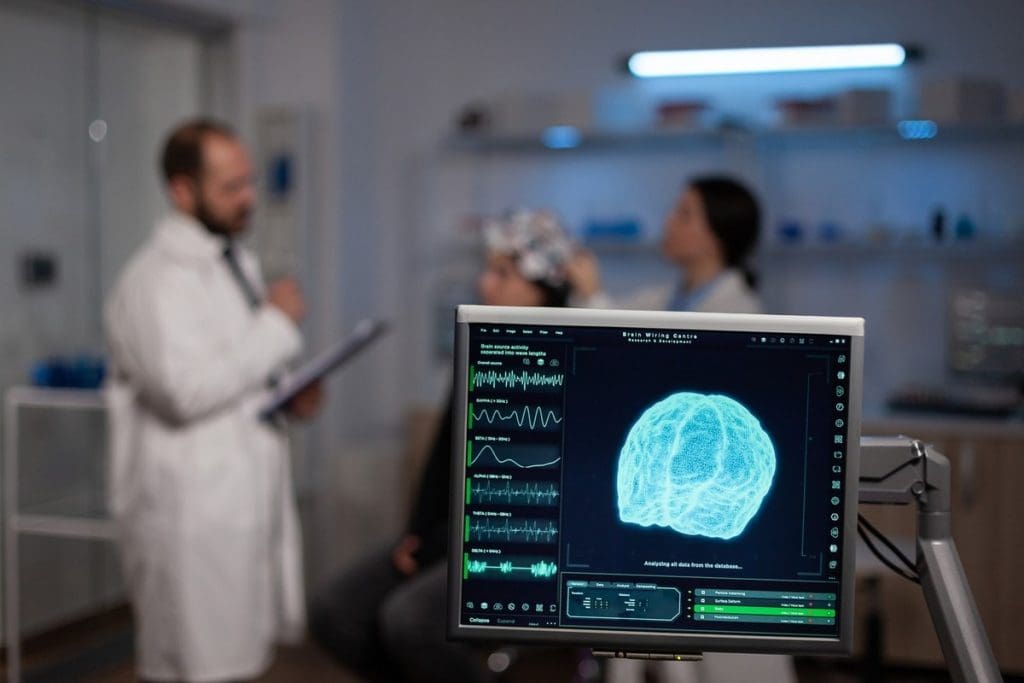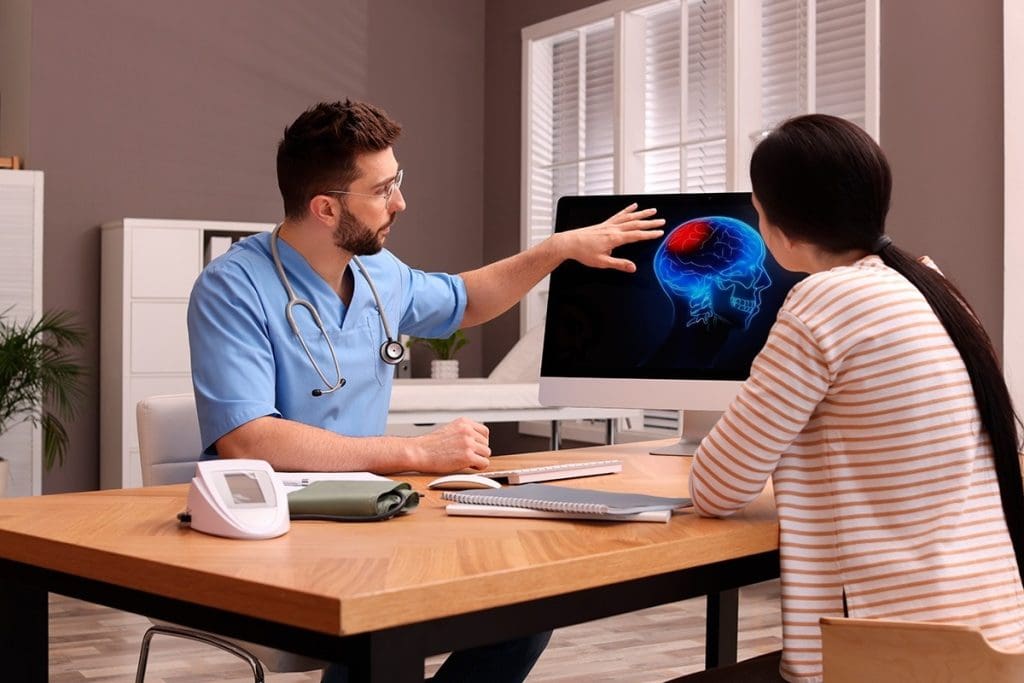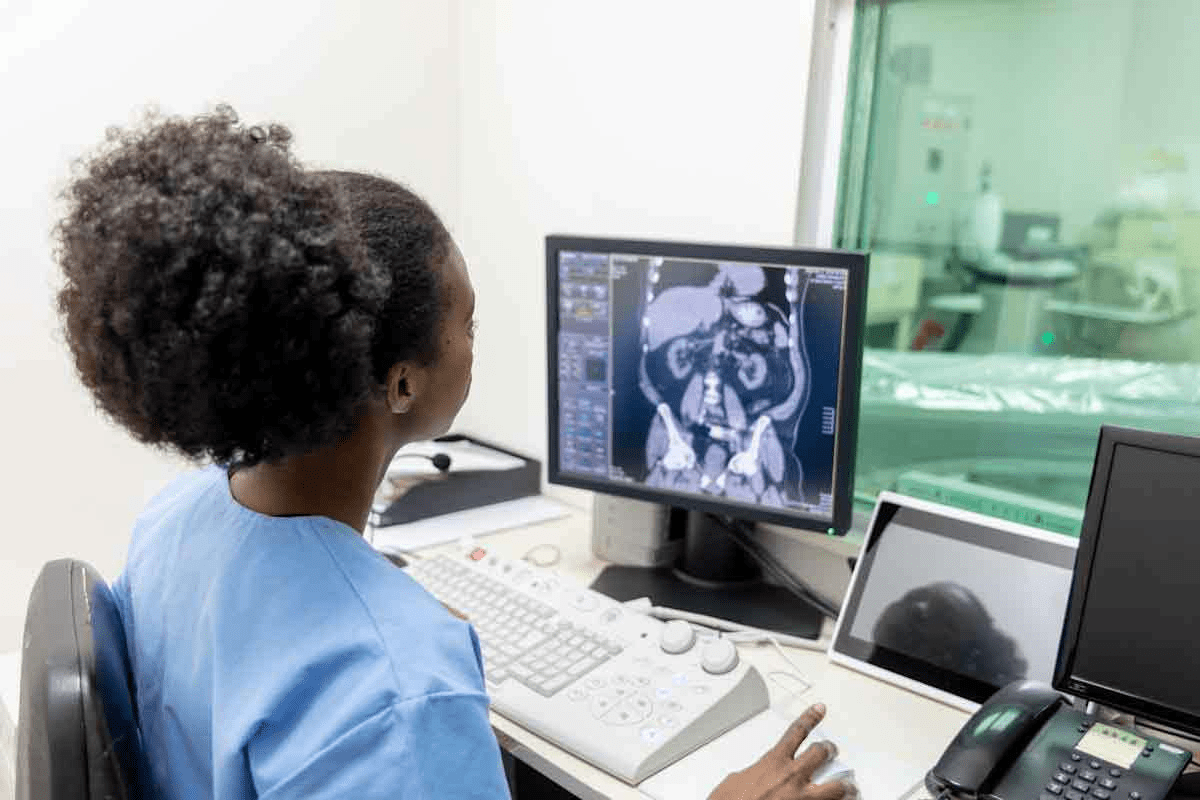Last Updated on November 27, 2025 by Bilal Hasdemir

At Liv Hospital, we know how worried people get about brain tumors. Accurate diagnosis is key to good treatment plans. We use top-notch tools like CT scans and MRI to find brain tumors.
CT scans can spot many brain tumors. But MRI is more sensitive and shows more details. A study on CT scans for brain tumor detection shows they are very good at finding tumors inside the brain.
It’s important to know what each imaging tool can do. We’ll look at how CT scans and MRI differ in finding brain tumors.
Key Takeaways
- CT scans can detect many types of brain tumors.
- MRI is more sensitive and provides more detailed images.
- CT scans are non-invasive and fast, providing detailed images of bone, soft tissue, and blood vessels.
- CT scans are effective at detecting calcifications and hemorrhages associated with certain brain tumors.
- The choice between CT scans and MRI depends on the specific diagnostic needs.
Understanding Brain Tumor Detection Methods

Brain tumor detection has come a long way. CT scans and MRI are now key tools in finding these tumors. These technologies help doctors spot tumors early and accurately.
Finding tumors early is key to better treatment and outcomes. Spotting them early can change the treatment plan and improve the patient’s chances.
The Importance of Early and Accurate Detection
Spotting brain tumors early is critical. It lets doctors act fast, which can lead to better results. Accurate diagnosis is also key. It helps doctors know the tumor’s type, where it is, and how serious it is. This info is vital for choosing the right treatment.
- Improved Treatment Outcomes: Early detection means doctors can tailor treatments to each patient’s needs.
- Reduced Risk: Accurate diagnosis lowers the chance of wrong or late diagnoses, which can cause problems.
- Enhanced Patient Care: Knowing the tumor’s details lets doctors give more personalized care.
Overview of Medical Imaging Technologies
Medical imaging is essential for finding and diagnosing brain tumors. CT scans and MRI are the main tools used. Each has its own benefits.
CT scans are great in emergencies because they’re quick and easy to get. They show where and how big the tumor is. MRI, though, gives detailed pictures of the brain’s soft parts. This makes it perfect for seeing what the tumor looks like.
We use these imaging tools to help decide on treatments and check if they’re working. By using both CT scans and MRI, doctors get a full picture of the patient’s situation.
The Science Behind CT Scans

CT scans use X-ray technology to show detailed images inside the body. This is key to finding many medical issues, like brain tumors.
How CT Technology Works
CT scans capture images by rotating an X-ray beam and detectors. These images are then pieced together to show the body’s inside parts. The whole process happens in a CT scanner, a big, doughnut-shaped machine.
Key components of a CT scanner include:
- X-ray tube: Produces the X-ray beam.
- Detectors: Capture the X-rays after they pass through the body.
- Computer system: Reconstructs the images from the data collected.
Types of CT Scans Used for Brain Imaging
There are many CT scans for brain imaging, each with its own use and benefits.
| Type of CT Scan | Description | Application |
| Non-contrast CT | Uses X-rays without a contrast agent. | Initial assessment of brain injuries or hemorrhages. |
| Contrast-enhanced CT | Involves the use of a contrast agent to highlight certain areas. | Detection of tumors, infections, and vascular abnormalities. |
| Perfusion CT | Measures blood flow to different areas of the brain. | Assessment of stroke and cerebral vasospasm. |
Knowing about the different CT scans and their uses is important. It helps doctors and patients make better choices about tests.
Will a CT Scan Show a Brain Tumor? Capabilities and Accuracy
CT scans are key in finding brain tumors. But how well they work depends on many things. We’ll look at how good CT scans are at finding brain tumors. We’ll talk about their success rates, what kinds of tumors they can spot, and their limits.
Detection Rates and Sensitivity Statistics
Research shows CT scans are very good at finding brain tumors. They have a 98.5% success rate in spotting them. This means they can find most brain tumors accurately. But, how well they do can change based on the tumor’s size, type, and the CT scan.
A study in a well-known medical journal found that CT scans work well. They’re best when tumors are big or have a lot of calcification. The study also stressed the need to use CT scans as part of a full check-up.
Types of Brain Tumors Best Detected by CT
CT scans are great at finding certain brain tumors. These include:
- Meningiomas, which are usually not cancerous and show up well on CT scans because of calcification.
- Gliomas, which can be different in how aggressive they are, and the more aggressive ones are easier to spot.
- Metastatic brain tumors, which start from cancers in other parts of the body.
These tumors often have features that make them stand out on CT scans. For more on how CT scans compare to MRI for finding brain tumors.
Limitations: Tumors That May Be Missed
Even though CT scans are good, they have their limits. They might miss small or low-grade tumors. These tumors are hard to see because they’re small or don’t show up well on scans. Also, tumors in some brain areas, like the posterior fossa, can be tricky to find because of bone artifacts.
It’s important to know these limits. CT scans should be part of a bigger plan that might include an MRI. Using different tests together can help doctors find tumors more accurately and plan better treatments.
The MRI Approach to Brain Tumor Detection
MRI has changed how we find brain tumors. It gives us clear images of soft tissues. This is a big step forward in medical imaging.
Fundamentals of MRI Technology
MRI uses strong magnets and radio waves to make detailed images. It’s safer than CT scans because it doesn’t use harmful radiation. It works by aligning hydrogen nuclei in the body and then disturbing them with radio waves.
When the nuclei return to their normal state, they send out signals. These signals help create the images we see.
Studies show MRI is very good at finding brain tumors. This is even more true when it’s used with advanced techniques like diffusion-weighted imaging (Source).
Types of MRI Sequences for Brain Tumor Imaging
There are different MRI sequences for brain tumor imaging. T1-weighted imaging shows the body’s anatomy. T2-weighted imaging highlights areas of swelling and tumor growth.
FLAIR (Fluid Attenuated Inversion Recovery) and Diffusion-weighted imaging give more details about tumors and the tissue around them. The right sequence depends on the tumor type and where it is.
By using several sequences, doctors can make a more accurate diagnosis. This helps them plan the best treatment.
Comparing Sensitivity and Specificity: CT vs. MRI
It’s important to know how CT scans and MRI differ in detecting brain tumors. Each has its own strengths and weaknesses. These affect how well they can spot and understand brain tumors.
Statistical Comparison of Detection Rates
Research shows MRI is better than CT scans at finding brain tumors, even small or low-grade ones. A study in the Journal of Neuro-Oncology found MRI-detected tumors in 95% of cases. CT scans only found them in 80% of cases.
MRI’s higher sensitivity helps see how big a tumor is and if it’s touching other parts. This is key for planning surgery and radiation therapy. A top neuroradiologist says, “MRI gives a clearer view of brain tumors. This helps doctors plan better treatments.”
“The superior soft-tissue contrast of MRI makes it the preferred imaging modality for brain tumor diagnosis and characterization.” –
A leading neuroradiologist
Tissue Differentiation Capabilities
MRI is great at showing different tissues because it gives clear, detailed images. This is vital for telling tumor types apart and seeing where they are. CT scans might find it hard to tell some soft tissues apart, leading to less accurate diagnoses.
Detection of Small and Low-Grade Tumors
MRI is really good at finding small and low-grade tumors that CT scans might miss. Finding these early is key to better treatment. MRI can spot these tumors early because it’s very sensitive to small changes in tissue.
In summary, MRI is a top choice for brain tumor detection because of its high sensitivity and specificity. Knowing the good and bad of each imaging method helps doctors choose the best for each patient.
Clinical Applications: When CT Scans Are Preferred
CT scans are key in finding brain tumors, mainly in emergencies. They give quick and accurate results, which is vital in urgent care.
Emergency Situations and Acute Symptoms
In emergency rooms, CT scans are the first choice for brain tumor signs like bad headaches or confusion. They’re fast and easy to get, perfect for urgent cases.
For example, someone with a bad headache and vomiting might get a CT scan. It’s fast and can save lives.
Initial Screening and Assessment
CT scans also help check for brain tumors when it’s not an emergency. They show tumor size, location, and possible problems. This helps doctors decide what to do next.
They help decide if surgery is needed and plan future care. The info from CT scans is key for treating brain tumors.
Patient-Specific Considerations
Choosing between CT scans and MRI depends on the patient. Some, like those with metal implants or claustrophobia, might do better with CT scans.
| Patient Condition | Preferred Imaging Modality | Rationale |
| Metal implants | CT | CT scans are not contraindicated with most metal implants |
| Claustrophobia | CT | CT scans are typically faster and less confining than MRI scans |
| Severe obesity | CT | CT scanners can accommodate larger patients more easily |
CT scans are also good for patients who can’t have an MRI. This includes those with certain medical devices or conditions.
Advanced MRI Techniques for Brain Tumor Diagnosis
Advanced MRI techniques are key in diagnosing and planning treatment for brain tumors. They give detailed info on the tumor’s structure, function, and metabolism. This helps doctors make accurate diagnoses and plan effective treatments.
Functional MRI and Diffusion Tensor Imaging
Functional MRI (fMRI) and Diffusion Tensor Imaging (DTI) offer deep insights into brain function and structure. fMRI shows brain activity by tracking blood flow changes. DTI, on the other hand, maps white matter tracts by following water molecule diffusion.
A study in the National Center for Biotechnology Information highlights their importance. These methods are vital for planning surgeries and assessing the risk of brain damage.
Key Benefits of fMRI and DTI:
- Precise localization of brain function
- Visualization of white matter tracts
- Enhanced preoperative planning
- Reduced risk of neurological damage
Perfusion and Spectroscopy Techniques
Perfusion-weighted imaging and MR spectroscopy are also used in diagnosing brain tumors. Perfusion-weighted imaging looks at tumor blood flow and vascularity. MR spectroscopy, on the other hand, examines tumor metabolism.
These methods help identify different tumor types and grades. This information guides treatment choices.
“Advanced MRI techniques, including perfusion-weighted imaging and MR spectroscopy, provide critical information for diagnosing and managing brain tumors.” –
Expert Opinion
| Technique | Application | Benefits |
| Perfusion-weighted Imaging | Assesses tumor vascularity | Helps differentiate tumor types and grades |
| MR Spectroscopy | Analyzes tumor metabolism | Guides treatment decisions |
AI-Assisted MRI Analysis and Diagnostic Accuracy
Artificial Intelligence (AI) is changing brain tumor diagnosis with MRI analysis. AI algorithms quickly process large datasets, spotting patterns humans might miss. This boosts diagnostic accuracy and speeds up analysis.
Advantages of AI-Assisted MRI Analysis:
- Improved diagnostic accuracy
- Faster analysis times
- Enhanced detection of subtle patterns
As we improve these MRI techniques, brain tumor diagnosis and treatment will get better. The future of neuroimaging combines human expertise with AI analysis. This will provide better care for patients with brain tumors.
Patient Experience and Practical Considerations
The experience of patients during brain imaging is shaped by several things. These include how well they are prepared, how comfortable they feel, and how easy it is to get to the imaging center. We aim to make sure patients are informed and comfortable every step of the way.
Preparing for Brain Imaging Procedures
Getting ready for brain imaging is important for a good experience. For CT scans, patients might need to skip eating or drinking for a few hours. This is because contrast dye might be used. For MRI, patients should remove metal items and tell their doctor about any metal implants or claustrophobia.
Following the instructions from your doctor or the imaging center is key. This might mean arriving early to fill out forms or bringing past imaging studies for comparison.
Comfort, Duration, and Accessibility Factors
Comfort levels can differ during brain imaging. CT scans are usually fast, taking just a few minutes. MRI scans, on the other hand, can last up to an hour. Some patients might feel uncomfortable because they have to stay very quiet or because of claustrophobia in the MRI.
To help with these issues, many places offer open MRI machines or sedation for those who are anxious. Knowing about these options can make a big difference in how patients feel.
Cost and Insurance Considerations
The cost of brain imaging can worry patients. Both CT scans and MRIs are considered diagnostic services, and their prices can change based on location, facility, and whether contrast is used.
| Procedure | Average Cost Range | Typical Insurance Coverage |
| CT Scan | $200 – $1,000 | The majority is covered, some out-of-pocket |
| MRI | $400 – $3,500 | The majority is covered, some out-of-pocket |
It’s a good idea for patients to check with their insurance about what’s covered and any costs they might have to pay out of pocket.
The Diagnostic Pathway: From Symptoms to Treatment Planning
The journey from symptoms to treatment planning for brain tumors is complex. It involves many steps and tools. We will look at how imaging and other methods help along the way.
First-Line Imaging Choices
When symptoms suggest a brain tumor, the first step is to pick the right imaging. CT scans are often chosen first because they are quick and easy to get. This is true, even in emergencies.
But MRI is better for seeing brain tumors clearly. It’s more sensitive and specific. The choice between CT and MRI depends on the patient’s symptoms and the suspected tumor type.
- CT scans are best in urgent cases or when an MRI can’t be used.
- MRI is better for detailed tumor checks and staging.
Follow-Up Imaging Protocols
After diagnosis, regular imaging checks are key. They help see how the tumor is responding to treatment and if it’s coming back. The type and how often these checks are done depend on the tumor and treatment plan.
- Regular MRI scans are used to track tumor changes.
- CT scans might be used when an MRI isn’t possible.
Advanced MRI, like functional MRI (fMRI) and diffusion tensor imaging (DTI, helps with surgery planning. They show how the tumor affects the brain around it.
Integration with Other Diagnostic Methods
Brain tumor diagnosis isn’t just about imaging. Biopsy and neurological examination are also key. They help confirm the diagnosis and check the patient’s brain health.
“The integration of imaging findings with clinical assessment and other diagnostic tests is essential for accurate diagnosis and effective treatment planning.”
We believe in a team effort. Radiologists, neurosurgeons, oncologists, and others work together. This ensures the best care for brain tumor patients.
Conclusion: The Complementary Role of CT and MRI in Brain Tumor Detection
We’ve looked at how CT scans and MRI help find brain tumors. They each have their own strengths and weaknesses. Together, they give us a better view of brain tumors.
Choosing between CT scans and MRI depends on the patient’s situation and the tumor type. CT scans are quick and good for emergencies. MRI, on the other hand, shows soft tissues better and helps see tumor details.
Using both CT scans and MRI together helps doctors make more accurate diagnoses. This team effort leads to better care for patients. It shows how CT and MRI work together to help detect brain tumors.
FAQ
Can a CT scan detect a brain tumor?
Yes, a CT scan can spot brain tumors. uBut how well it works depends on the tumor’s type and size. We often use CT scans first, but MRI is better for detailed views.
What are the advantages of MRI over CT scans in detecting brain tumors?
MRI is better at finding brain tumors, even small ones. It shows more detail and is great for tumors in tricky spots.
How does a CT scan work to detect brain tumors?
CT scans use X-rays to make detailed brain images. We look for tumors by finding odd masses or lesions that don’t look like normalbreastatissuen.
Are there any limitations to using CT scans for brain tumor detection?
Yes, CT scans can miss small or low-grade tumors. They also struggle with tumors near dense bones. MRI is usually more accurate for these cases.
Can a brain tumor be detected with a CT scan without contrast?
Some tumors might show up on a non-contrast CT scan. But contrast material makes tumors stand out more by showing their blood supply and edges.
How do advanced MRI techniques improve brain tumor diagnosis?
New MRI methods like functional MRI and spectroscopy give us more tumor details. This helps us plan treatments better.
What factors influence the choice between CT scans and MRI for brain tumor detection?
Choosing between CT and MRI depends on the situation. We consider if it’s an emergency, the patient’s health, and how detailed we need the images.
Do CT scans or MRI have different preparation requirements?
Yes, they do. MRI needs you to remove metal and might use contrast. We help patients get ready for each test to keep them safe and comfortable.
How do CT scans and MRI contribute to treatment planning for brain tumors?
Both scans are key for planning treatment. CT scans are quick, while MRI gives us detailed tumor info. This helps us make a solid treatment plan.
Can a CT scan detect brain cancer?
CT scans can spot some brain cancers, but it depends on the cancer’s type, size, and where it is. MRI is better for finding brain cancer, even in early stages.
Is an MRI or a CT scan better for detecting brain tumors?
MRI is usually better for finding brain tumors because it’s more sensitive. But CT scans are useful in emergencies or when quick images are needed.
References
- Centers for Disease Control and Prevention. (2023). Brain Tumors and Imaging.https://www.cdc.gov/cancer/brain/index.htm






